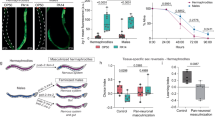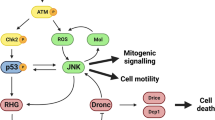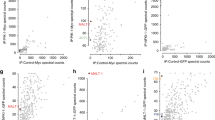Abstract
p73 (ref. 1) has high homology with the tumour suppressor p53 (refs 2,3,4), as well as with p63, a gene implicated in the maintenance of epithelial stem cells5,6,7. Despite the localization of the p73 gene to chromosome 1p36.3, a region of frequent aberration in a wide range of human cancers1, and the ability of p73 to transactivate p53 target genes1, it is unclear whether p73 functions as a tumour suppressor. Here we show that mice functionally deficient for all p73 isoforms exhibit profound defects, including hippocampal dysgenesis, hydrocephalus, chronic infections and inflammation, as well as abnormalities in pheromone sensory pathways. In contrast to p53-deficient mice, however, those lacking p73 show no increased susceptibility to spontaneous tumorigenesis. We report the mechanistic basis of the hippocampal dysgenesis and the loss of pheromone responses, and show that new, potentially dominant-negative, p73 variants are the predominant expression products of this gene in developing and adult tissues. Our data suggest that there is a marked divergence in the physiological functions of the p53 family members, and reveal unique roles for p73 in neurogenesis, sensory pathways and homeostatic control.
This is a preview of subscription content, access via your institution
Access options
Subscribe to this journal
Receive 51 print issues and online access
$199.00 per year
only $3.90 per issue
Buy this article
- Purchase on SpringerLink
- Instant access to full article PDF
Prices may be subject to local taxes which are calculated during checkout





Similar content being viewed by others
References
Kaghad, M. et al. Monoallelically expressed gene related to p53 at 1p36, a region frequently deleted in neuroblastoma and other human cancers. Cell 90, 809–819 ( 1997).
Kinzler, K. W. & Vogelstein, B. Life (and death) in a malignant tumour. Nature 379, 19– 20 (1996).
Ko, L. J. & Prives, C. p53: puzzle and paradigm. Genes Dev. 10, 1054–1072 (1996).
Levine, A. J. p53, the cellular gatekeeper for growth and division. Cell 88, 323–331 (1997).
Yang, A. et al. p63, a p53 homolog at 3q27-29, encodes multiple products with transactivating, death-inducing, and dominant-negative activities. Mol. Cell 2, 305–316 (1998).
Yang, A. et al. p63 is essential for regenerative proliferation in limb, craniofacial and epithelial development. Nature 398, 714–718 (1999).
Mills, A. A. et al. p63 is a p53 homologue required for limb and epidermal morphogenesis. Nature 398, 708–713 (1999).
De Laurenzi, V. et al. Two new p73 splice variants, gamma and delta, with different transcriptional activity. J. Exp. Med. 188, 1763–1768 (1998).
Capecchi, M. R. Altering the genome by homologous recombination. Science 244, 1288–1292 (1989).
Li, E., Bestor, T. H. & Jaenisch, R. Targeted mutation of the DNA methyltransferase gene results in embryonic lethality. Cell 69, 915–926 (1992).
Donehower, L. A. Mice deficient for p53 are developmentally normal but susceptible to spontaneous tumours. Nature 356, 215– 221 (1992).
Jacks, T. et al. Tumor spectrum analysis in p53-mutant mice. Curr. Biol. 4, 1–7 ( 1994).
Kim, K. C. et al. Airway goblet cell mucin: its structure and regulation of secretion. Eur. Respir. J. 10, 2644– 2649 (1997).
Matsui, H. et al. Evidence for periciliary liquid layer depletion, not abnormal ion composition, in the pathogenesis of cystic fibrosis airways disease. Cell 95, 1005–1015 ( 1998).
Cressman, V. L., Hicks, E. M., Funkhouser, W. K., Backlund, D. C. & Koller, B. H. The relationship of chronic mucin secretion to airway disease in normal and CFTR-deficient mice. Am. J. Respir. Cell. Mol. Biol. 19, 853–866 (1998).
Go, K. G. The normal and pathological physiology of brain water. Adv. Tech. Stand. Neurosurg. 23, 47–142 (1997).
Lindeman, G. J. A specific, nonproliferative role for E2F-5 in choroid plexus function revealed by gene targeting. Genes Dev. 12, 1092– 1098 (1998).
Stanfield, B. B. & Cowan, W. M. The morphology of the hippocampus and dentate gyrus in normal and Reeler mice. J. Comp. Neurol. 185, 393–422 (1979).
Rakic, P. & Caviness, V. S. Jr Cortical development: view from neurological mutants two decades later. Neuron 14, 1101–1104 (1995).
Ogawa, M. et al. The reeler gene-associated antigen on Cajal–Retzius neurons is a crucial molecule for laminar organization of cortical neurons. Neuron 14, 899–912 ( 1995).
D'Arcangelo, G. et al. A protein related to extracellular matrix proteins deleted in the mouse mutant reeler. Nature 374, 719–723 (1995).
Frotscher, M. Cajal–Retzius cells, Reelin, and the formation of layers. Curr. Opin. Neurobiol. 8, 570–575 (1998).
D'Arcangelo, G. & Curran, T. Reeler: new tales on an old mutant mouse. BioEssays 20, 235 –244 (1998).
Alcantara, S. et al. Regional and cellular patterns of reelin mRNA expression in the forebrain of the developing and adult mouse. J. Neurosci. 18, 7779–7799 (1998).
McEwen, B. S. Stress and hippocampal plasticity. Annu. Rev. Neurosci. 22, 105–122 (1999).
Gage, F. H., Kempermann, G., Palmer, T. D., Peterson, D. A., Ray, J. Multipotent progenitor cells in the adult dentate gyrus. J. Neurobiol. 36, 249 –266 (1998).
Bargmann, C. I. Olfactory receptors, vomeronasal receptors, and the organization of olfactory information. Cell 90, 585– 587 (1997).
Tirindelli, R. & Mucignat-Caretta, C., Ryba, N. J. Molecular aspects of pheromonal communication via the vomeronasal organ of mammals. Trends Neurosci. 21, 482–486 ( 1998).
Matsunami, H. & Buck, L. A multigene family encoding a diverse array of putative pheromone receptors in mammals. Cell 90, 775–784 (1997).
Herrada, G. & Dulac, C. A novel family of putative pheromone receptors in mammals with a topographically organized and sexually dimorphic distribution. Cell 90, 763– 773 (1997).
Acknowledgements
We would like to thank F. Borriello, H. Green, C. Westphal, P. Ferrara, T. Rapoport and L. Buck for helpful discussions; L. Du for blastocyst injections; A. Goffinet for the reelin antibody; H. Liu for the mouse genomic library; and J. Williams for histology preparation. This work was supported by the American Cancer Society and the Council for Tobacco Research (F.M.), and the NIH (R.B., A.S., P.D. and F.M.).
Author information
Authors and Affiliations
Corresponding authors
Rights and permissions
About this article
Cite this article
Yang, A., Walker, N., Bronson, R. et al. p73-deficient mice have neurological, pheromonal and inflammatory defects but lack spontaneous tumours. Nature 404, 99–103 (2000). https://doi.org/10.1038/35003607
Received:
Accepted:
Issue Date:
DOI: https://doi.org/10.1038/35003607
This article is cited by
-
TP73 Isoform-specific disruption reveals a critical role of TAp73beta in growth suppression and inflammatory response
Cell Death & Disease (2023)
-
Sustained glymphatic transport and impaired drainage to the nasal cavity observed in multiciliated cell ciliopathies with hydrocephalus
Fluids and Barriers of the CNS (2022)
-
Requirement for TP73 and genetic alterations originating from its intragenic super-enhancer in adult T-cell leukemia
Leukemia (2022)
-
DNA damage response revisited: the p53 family and its regulators provide endless cancer therapy opportunities
Experimental & Molecular Medicine (2022)
-
Structural diversity of p63 and p73 isoforms
Cell Death & Differentiation (2022)



